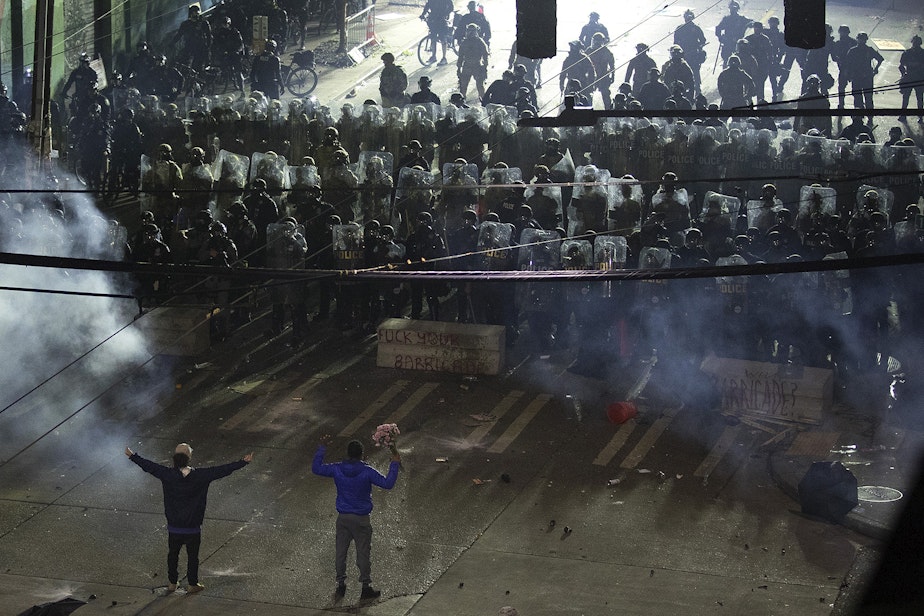Blastballs and projectiles: A fierce debate over Seattle Police use of force

Seattle’s Community Police Commission hosted a panel discussion Tuesday on proposed changes to Seattle Police Department's crowd control policies. But the dialogue ended with police officials and community members as far apart as they began.
Community organizer Nikkita Oliver opposed Seattle Police’s proposal for the use of specific crowd control weapons.
“I find it challenging to have a polite discussion about what is acceptable harm from the Seattle Police Department,” Oliver said.
“These documents say ‘less lethal force’ but really what they should say is ‘potentially lethal force.’ Things like blast balls, OC sprays in the midst of Covid, and pepperball launchers have the capacity to do extreme harm to people.”
The proposed policy makes no mention of tear gas, but specifies that police would have access to blast balls, pepper spray, 40mm sponge-tipped projectiles, and a new addition, “pepper balls” that emit a chemical irritant when fired, all to be used by trained officers if a crowd’s behavior creates a substantial risk of injuries or substantial harm to property.
Assistant Chief Lesley Cordner said pepper balls are meant “deal with isolated acts within a crowd, without having to use force on the rest of the crowd that’s not doing anything wrong.”
Sponsored
In Seattle, police use of crowd control devices has been controversial. A federal judge restricted them, and the City Council has banned them.
Alina Santillan, a Community Police Commission member who facilitated the event, said the proposed policy on crowd control weapons goes against the commission’s own recommendations.
“In August, we made our latest recommendations demanding that blast balls, tear gas and other crowd control weapons be banned,” Santillan said. “And SPD’s policies don’t address that.”
Becca Boatright, director for legal affairs at Seattle Police, said the police department sees crowd control weapons as a necessary contingency.
“It’s not enough to say ‘we don’t like this’ because we don’t like this either,” Boatright said. "How do you manage demonstrations that have the real potential to cause a life safety threat?”
Sponsored
Braxton Baker with the Seattle Group for Police Accountability said watching the riot in the U.S. Capitol earlier this month, he could see the need for crowd control weapons.
“Use your blast balls, tear gas, whatever the case may be, they’re literally rioting, breaking into the Capitol,” Baker said. “The difference for me is that’s not what’s happening here in Seattle. Yet we’re still being met with the same force.”
Assistant Chief Tom Mahaffey said Seattle Police has learned lessons since this summer, and greatly reduced its use of those weapons in recent months.
"We haven’t deployed a blast ball since the end of September,” Mahaffey said. But he said Seattle police also have to worry about people who want to harm them.
“The fact remains that I have two precincts surrounded by concrete barriers right now because they have been subject to having Molotov cocktails thrown at them, attempts were made to murder police officers by cementing a door closed while the rest of the building was lit on fire,” he said.
Sponsored
(That was in August; this week a man pleaded guilty to a federal charge for conspiracy to commit arson in that case).
The Community Police Commission said Seattle Police’s proposed policy also gives police too much discretion on when to call a protest ‘unlawful’ and disperse it. Critics said the policies also don’t adequately promote de-escalation during protests.
Assistant Chief Cordner said they do want to reduce Seattle Police’s visibility and footprint to prevent escalation at protests focused on police.
Travonna Thompson-Wiley with the Black Action Coalition said she’s been marching every Friday night in Seattle.
“I always had a question about why SPD would show up at our marches,” she said. “SPD’s mere presence does agitate people, especially when they flick on their lights.”
Sponsored
Boatright responded, “We show up because whenever a march takes over the travel way, the public roadway, there is a real risk to harm to the individuals in the march.”
Thompson-Wiley said it would be helpful if police could leave more distance between themselves and the marchers. Seattle Police are taking public comments on the policy changes through the end of the month. They will then have to be reviewed by a federal judge as part of the city’s longstanding consent decree.




